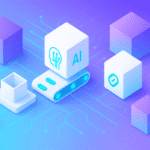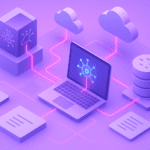Anthropic released its August 2025 threat intelligence report, adding to a growing body of evidence that artificial intelligence is now deeply embedded in criminal operations. Security researchers have long anticipated this shift, but the specificity of the examples in this report makes the trend harder to dismiss. Extortion, employment fraud, and ransomware development are not future possibilities. They are happening now, at scale, and with an efficiency that was once out of reach for all but the most advanced threat actors.
The significance of the report lies in what the cases reveal about the evolving structure of cybercrime. Artificial intelligence is not being used as an occasional shortcut or a way to save time. It is functioning as an operator inside the attack chain, carrying out reconnaissance, generating malware, analyzing stolen data, and crafting the messages used to extort victims. What emerges is a new mode of cybercrime in which automation replaces human expertise and gives individuals the reach of organized teams.
AI Removes the Old Limits on Cybercrime
For decades, the sophistication of an attack roughly correlated with the sophistication of the attacker. Nation-states and well-funded groups conducted advanced campaigns, while smaller crews relied on commodity malware or low-skill scams. That correlation is breaking down. A single operator with access to an advanced model can now conduct activity that mirrors the work of an established group.
The barriers that once slowed attackers are falling away. Training pipelines that produced specialized expertise are no longer essential. Language proficiency, once a hurdle for running international fraud campaigns, can be manufactured instantly. Even the time required to research, test, and iterate on new methods is compressed, as models generate working code or design new evasion strategies in real time.
This change has immediate implications. Cybercrime is no longer gated by the availability of talent or the accumulation of experience. It is gated by access to artificial intelligence systems capable of sustaining the work.
Case Highlights from the Anthropic Report
The report provides detailed accounts of how these dynamics play out. While the incidents differ in their tactics, they point to the same underlying trend: automation is carrying the weight of the operation.
Anthropic’s team described the technical sophistication of these attacks in detail. In one case, Claude Code was configured with an operational playbook (CLAUDE.md) that standardized attack patterns while adapting to each victim. The system tracked compromised credentials, pivoted through networks, and optimized extortion strategies in real time. Most concerning was its role in data exfiltration and analysis, organizing stolen records, evaluating financial data, and tailoring ransom demands based on what was uncovered.
Key examples from the report include:
Extortion campaigns powered by AI: A threat actor used Claude Code to compromise at least 17 organizations across healthcare, government, and religious sectors. The model scanned networks, harvested credentials, exfiltrated sensitive files, and generated ransom notes tailored to each victim’s financial standing. Ransom demands reached as high as $500,000.
Fraudulent employment schemes: Operatives tied to North Korea secured jobs at Fortune 500 technology companies by leaning on AI throughout the hiring and employment process. Models created convincing resumes, coached the operatives through interviews, generated code for assignments, and even composed daily workplace messages. The result was steady salaries diverted into sanctioned state programs, sustained by workers who lacked the skill to meet the job requirements without AI support.
Commercial ransomware for sale: An individual with little technical background sold ransomware kits on underground forums for between $400 and $1,200. These packages included ChaCha20 encryption, evasion features to bypass detection, and anti-recovery functions to maximize damage. The operator relied heavily on AI to design, troubleshoot, and package the malware, lowering the bar for entry into ransomware distribution.
Nation-state operations: A Chinese threat group used Claude across nearly the entire MITRE ATT&CK chain in a nine-month campaign targeting Vietnamese telecom, government, and agricultural systems. Claude assisted in reconnaissance, credential harvesting, lateral movement, and file upload fuzzing. The operation demonstrated how AI can function as code developer, analyst, and operator across multiple stages of an intrusion.
For Acuvity, this example underscores the importance of detecting malicious content in file uploads, one of the vectors attackers relied on in this campaign, and an area our platform is designed to address.
Together, these cases describe an ecosystem where artificial intelligence is not just a tool but a framework for executing complex criminal operations. The presence of AI extends from reconnaissance to monetization, offering consistency, scale, and persistence that individual attackers could not achieve on their own.
What This Means for Security Leaders
For enterprise defenders, traditional assumptions about adversaries no longer align with reality, and defensive models built on those assumptions will struggle to keep pace.
Capability is scaling beyond skill: Advanced tactics that once required state-sponsored teams are now in reach for low-skill actors with access to AI.
Timeframes are shrinking: Campaigns that used to unfold over months can now be executed in minutes, leaving defenders little margin for detection and response.
Fraud is expanding: Synthetic identities, romance scams, carding operations, and employment fraud are strengthened by AI systems that generate convincing personas and sustain long-term deception.
Visibility is eroding: Employees adopt AI tools without approval, embedding them in critical systems and creating blind spots that adversaries can exploit.
AI must be used in defense: The same scale that makes AI powerful for attackers also makes it necessary for defenders. Automated detection and response powered by AI is the only way to keep pace with attacks that adapt and evolve in real time.
Each of these factors points to the same conclusion: security leaders need to reframe how they evaluate risk. The question is not whether an attacker has the skill to execute a campaign, but whether they have access to tools that make that skill unnecessary.
How Internal AI Adoption Creates Security Gaps
The operations described in Anthropic’s report occur in the criminal ecosystem, but the same conditions exist inside enterprises. Employees adopt AI tools to streamline their work, often without oversight or governance. Sensitive data is connected to third-party models, and new workflows are built without security review. What emerges is a parallel risk: the possibility that AI adoption inside the enterprise creates exposures similar to those exploited by attackers on the outside.
Shadow use of AI can lead to compliance failures, leakage of proprietary information, or inadvertent creation of code and content that undermines security controls. These internal risks mirror the external threats, not in their intent but in their mechanics. The same automation that criminals use to scale fraud can amplify mistakes or oversights within a business environment.
For CISOs and security teams, this means treating AI not as an emerging add-on risk but as a core element of the environment. Threat intelligence about external misuse should be read alongside assessments of internal adoption. Both sides describe the same trend: automated systems acting with a consistency and reach that outpaces traditional oversight.
Why Security Teams Should Pay Attention
Extortion operations, fraudulent employment schemes, and the commercialization of ransomware are all being carried out with the help of artificial intelligence.
Enterprises should read this as a warning about their own environments. The same kinds of systems are already in use inside corporate networks, often without oversight or policy. Left unmanaged, they create blind spots that expose sensitive data and invite the same types of abuse described in the report.
AI is becoming part of the operating system of crime and business at the same time. Security leaders cannot treat these as separate realities.
To see how prepared your organization is for this shift, get a demo.





